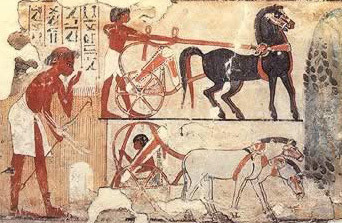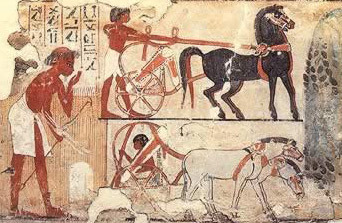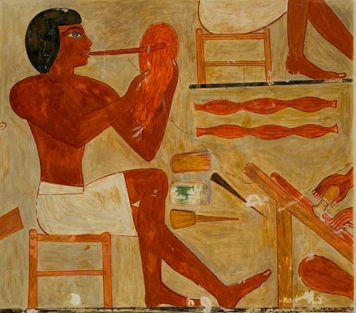E.Y. Laster's Blog
July 18, 2021
KINGS OF THE SKY

Here, the 16th Century bust (brass and bronze) of an Oba, king, of the Benin Empire. The Edo people of Benin are descendants of an ancient warrior kingdom known as Igodomigodo, which existed as early as 350 B.C. During the Igodomigodo Kingdom era, the Edo were ruled by Ogisos, ‘kings of the sky.’ Following the death of the last Ogiso, the Igodomigodo chiefs experienced political and social instability and requested help from the neighboring Ife Kingdom. According to history, the Ife King sent his son, Prince Oranmiyan Odede, to help stabilize the kingdom. During his stay, he took a woman named Erinmwide as his wife and the two had a son, Eweka I, who became the king of the Edo people and Oba of the newly named Benin Empire. The ancient Empire of Benin had its seat in Benin City of modern day Nigeria where the Eweka dynasty still exists today. Their fashion, language, and art is a testament to their rich culture and ancient traditions.
Photo Credit: https://www.metmuseum.org/art/collect...
February 27, 2021
Free on Amazon
May 27, 2020
MEMNON: An Ethiopian King and Hero in Greek Mythology

Μemnon: An Ethiopian king, demigod, and Greek hero whose skill in battle was considered to be almost equal to Achilles. In ancient Greek mythology, Memnon was born of Tithonus, a mortal prince of Troy, and Eos, immortal goddess of the dawn. Known as the “son of Dawn,” Memnon was raised by Hesperides, nymphs associated with the evening and golden sunsets. According to the lost epic poem Aethiopis, Memnon returned from his kingdom in Ethiopia to defend Troy during the Trojan war, killing Antilochus, a favorite of Achilles. Hydrias like this one from approximately 500 B.C. depict the great battle between the two heroes, Memnon and Achilles, as their goddess mothers, Eos and Thetis, watched close by. Achilles ultimately killed Memnon, who falls into the devastated arms of Eos and is carrried back to Ethiopia. Moved by her tears, Zeus grants Memnon immortality.
First pic: ca. 500 B.C. - Hydria (water jug) depicting fallen hero Memnon being carried away by Eos (Metmuseum)
Second pic: 2nd Century A.D. - Greek statue of Memnon, an Ethiopian pupil of philosopher Herodes Atticus, named for the Greek hero Memnon (Berlin State Museums)
For More Info: https://www.metmuseum.org/art/collect... and https://www.metmuseum.org/art/collect... and http://www.smb-digital.de/eMuseumPlus...
Learn more
May 16, 2020
Maryannu. 'Chariot Warriors' and 'Young Heroes' of Ancient Egypt

Maryannu was derived from the ancient Sanskrit term 'marya' and was used to identify charioteers serving in the pharaoh's army. The name maryannu appeared in the Amarna letters of Haapi, a commissioner around 1350-1355 B.C. Used as the first line of defense during battle, the chariot would be driven by one soldier while a second shot arrows and spears at their enemies. The Hyksos were the first attested people to use the chariot, while still more accounts indicate that Pharaoh Kamose of the 17th dynasty became the first pharaoh to use chariots in battle, dealing him great victories. Pictured here is a hunting scene using a chariot from the Tomb of Userhat. The second picture is a Nubian princess riding in an ox-driven chariot to provide gifts to the Pharaoh taken from the Tomb of Huy.
Photocredit: Metmuseum, University of Chicago
For more info: See http://www.bbc.co.uk/worldservice/afr... and https://oi.uchicago.edu/museum-exhibi...
May 5, 2020
GIVING TUESDAY

Giving Tuesday
In honor of Giving Tuesday, Of Captivity & Kings donated to World Central Kitchen, a not-for-profit organization dedicated to providing meals for those affected by natural disasters.
World Central Kitchen is currently active in dozens of cities across America in the wake of Covid-19, providing 250,000 fresh meals to children, families, and seniors daily with the help of small independent restaurants and delivery drivers.
It does not matter how small your contribution is to improve the world. It only matters that you tried.
April 18, 2020
BARBERS IN KEMET & ANCIENT EGYPT ...

Barbers have long held a coveted position in history, being highly respected in Kemet and ancient Egypt. The first barbering services were recorded in 5000 B.C. in Kemet with tools formed from flint and oyster shells. Services were not limited to royals and nobility as everyone from soldiers to children could have their heads shaved and facial hair removed. Hair removal in Kemet was arduous but essential. Both men and women had their heads shaved, a process that helped them stay cool in the heat. The writings of historian Herodotus in 400 BC revealed that Egyptian priests often shaved their entire bodies to avoid lice or any other impurity such as dirt that might interfere with their service to their gods. While in mourning, priests would allow their hair to grow. Razors, tweezers, and sharpened knives such as the one pictured have been found in tombs dating back to 1560 B.C. The great houses of the Pharaohs kept barbers on retainer and extended services to visitors and guests as a mark of hospitality. Barbers held great positions of trust, and served not only in the private sector but for kings and within temple walls. One such responsibility was given to a barber known as Ankhpakhered, a temple barber serving Amun, one of the gods of Karnak. His cartonnage, or funerary covering, was vibrant, colorful, and painted with winged deities. When a person holding a razor to your scalp or your throat doesn’t slip - it’s always a blessing.
Photo Credit: The Metropolitan Museum of Art
For more information: https://www.metmuseum.org/art/collect... and https://www.vice.com/sv/article/wdax4... and https://www.louvre.fr/en/oeuvre-notic...
BARBERS IN KEMET & ANCIENT EGYPT
...

Barbers have long held a coveted position in history, being highly respected in Kemet and ancient Egypt. The first barbering services were recorded in 5000 B.C. in Kemet with tools formed from flint and oyster shells. Services were not limited to royals and nobility as everyone from soldiers to children could have their heads shaved and facial hair removed. Hair removal in Kemet was arduous but essential. Both men and women had their heads shaved, a process that helped them stay cool in the heat. The writings of historian Herodotus in 400 BC revealed that Egyptian priests often shaved their entire bodies to avoid lice or any other impurity such as dirt that might interfere with their service to their gods. While in mourning, priests would allow their hair to grow. Razors, tweezers, and sharpened knives such as the one pictured have been found in tombs dating back to 1560 B.C. The great houses of the Pharaohs kept barbers on retainer and extended services to visitors and guests as a mark of hospitality. Barbers held great positions of trust, and served not only in the private sector but for kings and within temple walls. One such responsibility was given to a barber known as Ankhpakhered, a temple barber serving Amun, one of the gods of Karnak. His cartonnage, or funerary covering, was vibrant, colorful, and painted with winged deities. When a person holding a razor to your scalp or your throat doesn’t slip - it’s always a blessing.
Photo Credit: The Metropolitan Museum of Art
For more information: https://www.metmuseum.org/art/collect... and https://www.vice.com/sv/article/wdax4... and https://www.louvre.fr/en/oeuvre-notic...
April 15, 2020
HORSES OF KUSH & NUBIA ...

Nubians and Kushites were renowned horse masters. The Kingdom of Kush would trade them in peacetime, use them for chariots during war, and even domesticate them for daily use. The Kushite stallions, noted by their black coats and ivory legs, were famous throughout the ancient world in ancient Kemet, Rome, and Assyria. Those who worked with or handled horses were especially prized, and Kushites were known to serve as horse grooms, riders, trainers, breeders, and charioteers. Several ancient Assyrian documents such as the Nineveh Horse Reports of 8th century B.C. mention the superiority of the “horses of Kush” and record receiving numbers in the thousands through trade throughout the Assyrian empire. One neo-Assyrian text cites a Kushite horse expert and “chariot driver of the Prefect of the Land” holding a high office in the military. The Kingdom of Kush often traded luxuries such as ebony, ivory, and Kushite stallions to ancient Egypt. Pharaoh Piye’s Victory Stele lamented the condition of horses found starving in the stables of a recently conquered city of Egypt. Pharaoh Piye remarked “…As I live, as Re loves me, as my nose is rejuvenated with life, how much more painful it is in my heart that my horses have been starved than any other crime that you have committed at your discretion.” In the 8th century A.D., John the Deacon, an Egyptian chronicler of early Christian Nubian Kingdoms, made note of how highly trained the Nubian horse was. Nubian horses would kick enemies using their front and hind legs in battle while riders fought atop their backs. Pictured here is a painting of a horse drawn chariot part of a larger limestone fragment taken from the tomb of 18th dynasty official Nebamun.
Photo Credit: British Museum
For More Information: https://www.cambridge.org/core/journa... and https://www.journals.uchicago.edu/doi...
HORSES OF KUSH & NUBIA
...

Nubians and Kushites were renowned horse masters. The Kingdom of Kush would trade them in peacetime, use them for chariots during war, and even domesticate them for daily use. The Kushite stallions, noted by their black coats and ivory legs, were famous throughout the ancient world in ancient Kemet, Rome, and Assyria. Those who worked with or handled horses were especially prized, and Kushites were known to serve as horse grooms, riders, trainers, breeders, and charioteers. Several ancient Assyrian documents such as the Nineveh Horse Reports of 8th century B.C. mention the superiority of the “horses of Kush” and record receiving numbers in the thousands through trade throughout the Assyrian empire. One neo-Assyrian text cites a Kushite horse expert and “chariot driver of the Prefect of the Land” holding a high office in the military. The Kingdom of Kush often traded luxuries such as ebony, ivory, and Kushite stallions to ancient Egypt. Pharaoh Piye’s Victory Stele lamented the condition of horses found starving in the stables of a recently conquered city of Egypt. Pharaoh Piye remarked “…As I live, as Re loves me, as my nose is rejuvenated with life, how much more painful it is in my heart that my horses have been starved than any other crime that you have committed at your discretion.” In the 8th century A.D., John the Deacon, an Egyptian chronicler of early Christian Nubian Kingdoms, made note of how highly trained the Nubian horse was. Nubian horses would kick enemies using their front and hind legs in battle while riders fought atop their backs. Pictured here is a painting of a horse drawn chariot part of a larger limestone fragment taken from the tomb of 18th dynasty official Nebamun.
Photo Credit: British Museum
For More Information: https://www.cambridge.org/core/journa... and https://www.journals.uchicago.edu/doi...
March 23, 2020
RISE OF THE SANDAL BEARER ...

Sandal makers and sandal bearers played an important role in Kemet and ancient Egypt. They were responsible for creating footwear for pharaohs, nobility, and commoners alike, especially when a person knew they would be traveling through dangerous or muddy terrain. Pharaoh Narmer, the first King of Kemet, was often depicted barefoot in keeping with other depictions of commoners, kings, and nobility. However, the Narmer palette, a slate green carving dating to 3200 B.C., represents Pharaoh Narmer barefoot and followed by a sandal bearer while Narmer himself uses one hand to hold his kneeling enemy and the other to raise his mace to smite him. Still more revealing of the importance of sandal bearers is the autobiography of Weni the Elder, a court official from the 6th Dynasty. Weni wrote that “When I was chamberlain of the palace and sandal-bearer, King Mernere, my lord who lives forever, made me Count and Governor ofUpper Egypt, from Yebu in the south to Medenyt in the north, because I was worthy in his majesty's heart, because I was rooted in his majesty's heart, because his majesty's heart was filled with me.” Even the 18th dynasty soles of a pair of sandals found in Pharaoh Tutankhamen’s tomb contained decorations of the Pharaoh’s enemies. Made from straw, leather and even gold, these people knew the importance of putting their best foot forward.
Photo credit: Metmuseum
For more info see: http://people.loyno.edu/~gerlich/161.... and https://www.britishmuseum.org/pdf/Vel...
Note: As an official of the 6th dynasty, “Upper Egypt” would not have been a term Weni knew or used as “Egypt” evolved from a Grecian term. The modern name Upper Egypt was actually Ta-Shemau in ancient times, a phrase meaning “The Land of Reeds.” Lower Egypt was called Ta-Mehu in ancient times, a phrase meaning “Land of Papyrus.”



